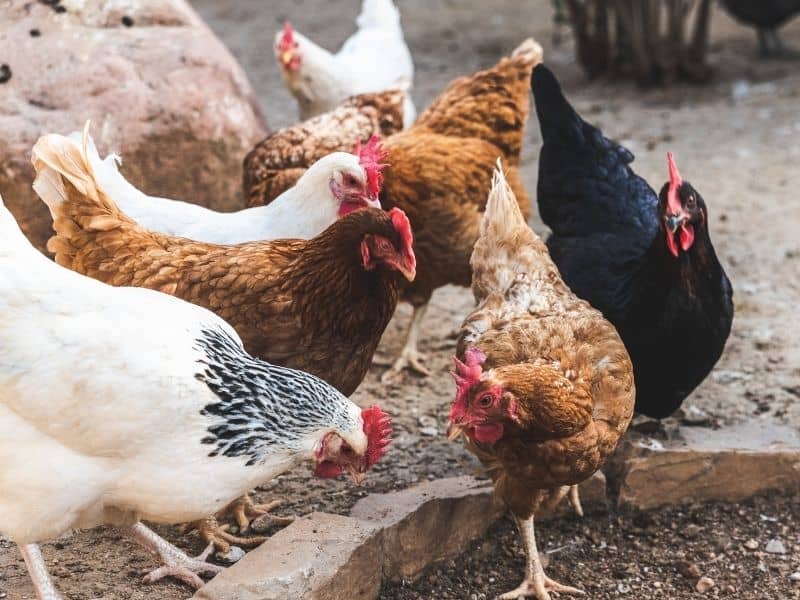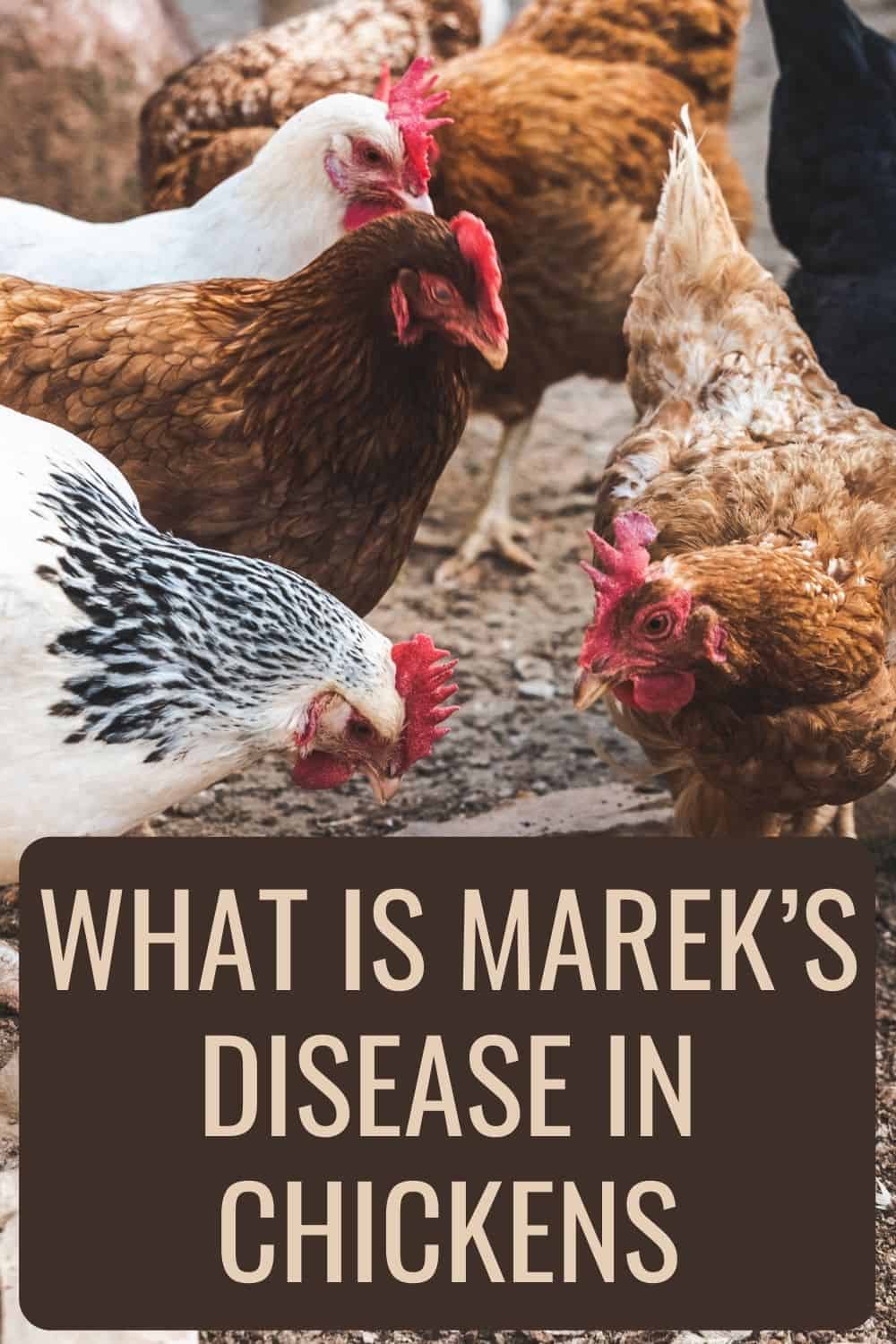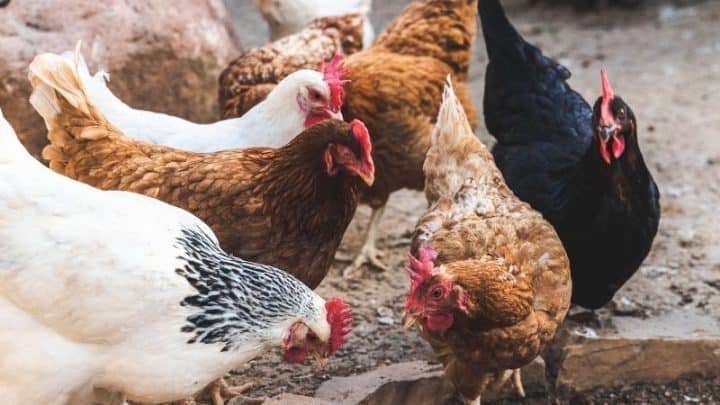Along with owning chickens comes some new territory as far as illness and disease go. Learning about some of the more common diseases will help you to gain a better understanding of what to look for and how to tackle them should they arise. Marek’s disease in chickens is one of the most common illnesses found in backyard flocks. Today we’ll look at the causes, what to look for and how to deal with this debilitating and deadly disease.

What Is Marek’s Disease In Chickens
Marek’s is a highly contagious viral neoplastic disease found in chickens. It is a form of the herpes virus that is very easily transmitted from bird to bird when dander from an infected bird is inhaled by another bird.
Chickens are constantly shedding which means the disease is ever-present in the coop and run of an infected flock. This can lead to the disease hanging around long after all birds are gone, which is why it can be extremely difficult to get rid of entirely. There are many different opinions in the chicken world on how to deal with Marek’s disease. Let’s discuss the symptoms, options, and maintenance of this common illness.
Related:
- The basics of raising baby chicks
- How to predator-proof the chicken coop and run
- Chicken dust bath: ingredients, tools, and FAQs
Symptoms of Marek’s disease
Marek’s can manifest in four different forms, each form displaying a different set of symptoms:
- neural
- cutaneous
- ocular
- visceral
The most common type of Marek’s is the Neural Form. Birds infected with this form of Marek’s generally present with progressive paralysis that is commonly seen as one leg extended out to the front and the other underneath the bird or protruding back. This happens when the disease infiltrates the sciatic nerve.
You will also notice other signs such as weight loss, diarrhea, and labored breathing. Most of the time the bird will starve due to its inability to get to a food source. The best course of action when a bird is presenting with these advanced systems is to humanely put it down.
The other three forms of Marek’s are less common and not as obvious.
Cutaneous Form manifests in swollen feather follicles on the skin that can form crusty scabs.
Ocular Form causes grey eye color and a misshapen iris from the infection of lymphocytes in the eye.
Visceral Form presents as tumors in the internal organs such as the heart, kidney, liver, ovaries, and lungs.
What to do if your chickens have Mareck’s
When talking about Marek’s you really only have two options:
- cull your entire flock and start from scratch
- maintain a closed flock and only add birds that have been vaccinated against Marek’s.
Since there is no treatment or cure for Marek’s these two options are all you have…
Culling
This option involves euthanizing the entire flock, thoroughly cleaning and sanitizing your entire farm, and letting the land sit for a while before introducing new chickens. If you choose this method, you’ll need to only buy vaccinated birds from here on out. Adding unvaccinated chickens can put you right back at square one with the reintroduction of the disease.
Maintaining your current flock
if you choose to keep the chickens you have you’ll need to completely close your flock, which means no birds leave your property and no birds come onto your property.
If you choose this method, breeding for resistance may be a route that you would like to explore. I won’t get into all of the specifics of that innow, but will write more about it in the near future.
If you choose to maintain your flock, be prepared for losses. Some birds are able to handle the disease better than others. This is another factor in breeding for resistance. You’ll want to use only your strongest birds when growing your future flock. If birds start to become weak and show obvious signs you’ll have to make the difficult choice to euthanize.
Out of the two options when dealing with Marek’s I would choose this one. Simply because Marek’s is so present in our environment that the chances of reinfection are quite likely. And even vaccinated birds can still be carriers.
Some important things to know about Marek’s Disease
- Marek’s disease is not transmitted vertically. This simply means a hen cannot pass the virus through her egg. Newly hatched chicks will not have Marek’s disease. They are not born with it. If they contract it later it’s because of contact with an infected bird’s dander.
- You can transport Marek’s on your clothing, shoes, and implements used when tending to an infected flock. Biosecurity is of the utmost importance when dealing with a virus as highly contagious as this one.
- Vaccinated birds can still be carriers. This is why it is very important to only add vaccinated birds to a flock of existing vaccinated chickens. Adding unvaccinated birds puts them at risk for contracting the disease should one of your vaccinated chickens be a carrier. It can get very complicated and confusing, so if you start with a vaccinated flock just continue to only add vaccinated birds. Chicks can be given the vaccine in ova, meaning while still in the egg or as a day-old chick. Some hatcheries offer chicks vaccinated for Marek’s: check around and see which ones do.
- Make sure you maintain a clean and healthy environment for your flock. This should go without saying, but the healthier your birds are the better chance they have of coping with a disease such as Marek’s.
- If you notice one of your birds presenting with illness, immediately remove them from the flock and isolate them to a quarantine area far from your birds. If the illness is advanced and the bird is not likely to survive, euthanasia will most likely be the kindest option. Most states have a lab where birds can be sent for necropsy at a nominal cost. This is the only way to know for sure if Marek’s is the cause. And if it is you’ll know for certain what you are dealing with and be able to take steps forward for the rest of your flock.
- Marek’s tends to manifest when a chicken is in the teenage stage, around 14-25 weeks. It can happen at any time but this age is the most common, just before laying age.
- Not every chicken that is exposed to Marek’s succumbs to the virus, but every chicken that shows advanced symptoms will die. The mortality rate of birds that are infected is essentially up to 100% and morbidity is between 10-50%.
In summation, now that you have the answer to “what is Marek’s disease in chickens”, you know that Marek can be a very scary word in the chicken community, but it doesn’t necessarily have to be a death sentence for your entire flock. Prevention is key.
Learn more about raising chickens
Do a bit of research and decide where you stand on the culling vs. breeding for resistance issue. And above all don’t stress too much. There are many illnesses and diseases when dealing with chickens, but there are also many rewards. A clean, bio-secure environment is a good place to start.




Kathya Briggs
Sunday 3rd of December 2023
Hello, Currently lost 2 of my 20 hens to Mareks. Some have respiratory infection too as well as parasites. When it rain, it pours. After reading your post, when you say breading resistance, what do you exactly mean? Sorry, English is my second language. You mean that if I let my hen hatch some chickies, will they be born with resistance to the disease or, that I am creating resistance in my current flock to this disease?
Thank you!!!
Adriana
Sunday 3rd of December 2023
Breeding for resistance means you are breeding strong chickens that will resist to disease. Read more about it here: https://www.ambresse.com/selective-breeding.html
7 Respiratory Diseases In Chickens And What To Do When Your Chickens Get Them
Monday 27th of March 2023
[…] What Is Marek’s Disease In Chickens […]
Quick Guide To Raising Backyard Chickens
Monday 27th of March 2023
[…] What Is Marek’s Disease In Chickens […]